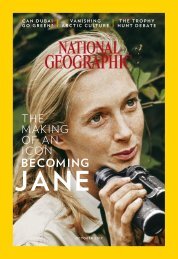NC
You also want an ePaper? Increase the reach of your titles
YUMPU automatically turns print PDFs into web optimized ePapers that Google loves.
A FEEDING STRATEGY<br />
Jane sits on the concrete foundation of<br />
the new feeding station she and Hugo<br />
built, up the hill from their lakefront<br />
<br />
near camp, to draw chimps to observe<br />
<br />
bananas became aggressive, they<br />
moved the site farther away.<br />
Jane wrote to others that she was “horrified”<br />
by the overture from Leakey, who was 30 years<br />
her senior and married. For months after Jane<br />
told him firmly that she’d never return his feelings,<br />
Leakey still sent her love letters.<br />
In an interview years later with Virginia Morell,<br />
author of a book on the Leakey family, Jane<br />
said that “what I was most afraid of was what my<br />
rejection of him might mean for my study of the<br />
chimpanzees.” But Leakey never withdrew his<br />
support—and by the summer of 1960 Jane was<br />
setting up camp in the Gombe Stream Reserve<br />
near the shores of Lake Tanganyika, with enough<br />
funding for six months of fieldwork. Because government<br />
officials wouldn’t allow a lone female to<br />
live in the reserve, Vanne Morris-Goodall came<br />
along as her daughter’s chaperone.<br />
From the start Jane followed her instincts<br />
for conducting research. Not knowing that the<br />
established scientific practice was to use<br />
numbers to identify animals under study, she<br />
recorded observations of the chimps by names<br />
she concocted: Fifi, Flo, Mr. McGregor, David<br />
Greybeard. She wrote about the chimps as<br />
individuals with distinct traits and personalities—for<br />
example, when a female she called<br />
Mrs. Maggs was preparing a treetop nest for the<br />
night, Jane wrote that the chimp had “tested<br />
the branches exactly the way a person tests the<br />
springs of a hotel bed.”<br />
She spent most waking hours locating the<br />
animals through her binoculars, then trying to<br />
draw gradually closer so they’d get used to her<br />
presence as she sat jotting notes. But with one<br />
month left in the study grant, she hadn’t made<br />
the kind of significant discovery she felt would<br />
justify Leakey’s faith in her.<br />
As her study was approaching its end, Jane<br />
made three discoveries that would not only make<br />
Leakey proud but would also turn established<br />
science on its head.<br />
In her first discovery, she observed a chimp<br />
gnawing on the carcass of a small animal, which<br />
belied the prevailing belief that apes didn’t eat<br />
meat. The chimp was memorable for his prominent<br />
gray goatee, and she would name him David<br />
Greybeard. He in turn would open the door for her<br />
42 NATIONAL GEOGRAPHIC • OCTOBER 2017



